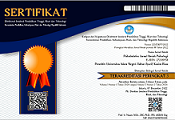Uji Validitas Konstruk The Centrality of Religiosity Scale (CRS-15) Pada Sampel Muslim
Abstract
Penelitian ini bertujuan untuk menguji validitas konstruk instrumen The Centrality of Religiosity Scale (CRS-15) yang telah diadaptasi ke dalam bahasa Indonesia. Partisipan dalam penelitian ini berjumlah 205 mahasiswa Muslim di Yogyakarta dan Pekanbaru. Partisipan terdiri dari 117 (57,1%) laki-laki dan 88 (42,9%) perempuan dengan rentang usia 18-31 tahun (Mage= 21). Metode yang digunakan dalam penelitian ini adalah Confirmatory Factor Analysis (CFA) first order dengan menggunakan software Lisrel 8.80. Hasil penelitian ini menunjukkan bahwa model pengukuran religiusitas lima dimensi telah memenuhi kriteria Goodness of Fit Statistics: Chi-Square χ2 (80) =90.69, p=0.194 (p>0.000), RMSEA=0.026 (p<0.06), Non-Normed Fit Index (NNFI)/TLI = 0.984, Comparative Fit Index (CFI) = 0.988, Standardized RMR = 0.0576. Hasil penelitian ini juga menunjukkan bahwa butir-butir dalam pengukuran ini secara valid mengukur dimensi religiusitas (T>1.96), dengan rentang R2 berkisar diantara 0.06 – 0.61. Confirmatory Factor Analysis (CFA) Second Order dapat dilakukan peneliti selanjutnya untuk memastikan apakah dimensi intelektual, ideologi, ibadah publik, ibadah individual dan pengalaman/penghayatan valid membentuk konstruk religiusitas.
Keywords
Full Text:
PDFReferences
Abbasi, S. B., Kazmi, F., Wilson, N., & Khan, F. (2019). Centrality of religiosity scale (CRS) confirmatory factor analysis. 3(4), 319–324. https://doi.org/10.15406/sij.2019.03.00193
Ackert, Maglakelidze, Badurashvili, & Huber. (2020). Validation of the Short Forms of the Centrality of Religiosity Scale in Georgia. Religions, 11(2), 57. https://doi.org/10.3390/rel11020057
Aditya, Y., Martoyo, I., Nurcahyo, F. A., Ariela, J., & Pramono, R. (2021). Factorial structure of the four basic dimensions of religiousness (4-BDRS) among Muslim and Christian college students in Indonesia. Cogent Psychology, 8(1). https://doi.org/10.1080/23311908.2021.1974680
Allport, G. W., & Ross, J. M. (1967). Personal religious orientation and prejudice. In Journal of Personality and Social Psychology (Vol. 5, Nomor 4, hal. 432–443). American Psychological Association. https://doi.org/10.1037/h0021212
Amir, Y. (2021). Pengembangan Skala Religiusitas untuk Subyek Muslim. Indonesian Journal for The Psychology of Religion, 1(1). https://doi.org/10.24854/ijpr403
Beaton, D. E., Bombardier, C., Guillemin, F., & Ferraz, M. B. (2000). Guidelines for the Process of Cross-Cultural Adaptation of Self-Report Measures. Spine, 25(24), 3186–3191. https://doi.org/10.1097/00007632-200012150-00014
Brown, T. A. (2015). Confirmatory factor analysis for applied research (2 ed.). Guilford publications.
El-Menouar, Y. (2014). The Five Dimensions of Muslim Religiosity . Results of an Empirical Study. Method, Data, Analyses, 8(1), 53–78. https://doi.org/10.12758/mda.2014.003
El Hafiz, S. (2022). Skala Religiusitas Muslim Indonesia: Mencari Pengukuran Aspek Beragama yang Valid. Jurnal Psikologi Islam, 8(1). https://doi.org/https://doi.org/10.47399/jpi.v8i1.131
Esperandio, M. R. G., August, H., Viacava, J. J. C., Huber, S., & Fernandes, M. L. (2019). Brazilian validation of centrality of religiosity scale (CRS-10BR AND CRS-5BR). Religions, 10(9), 1–15. https://doi.org/10.3390/rel10090508
Gheorghe, H. (2019). The psychometric properties of a romanian version of the centrality of religiosity scale (CRS 15). Religions, 10(1). https://doi.org/10.3390/rel10010011
Glock, C. Y. (1962). On The Study of Religious Commitment. Religious Education, 57(sup4), 98–110. https://doi.org/10.1080/003440862057S407
Hooper, D., Coughlan, J., Mullen, M. R., Mullen, J., Hooper, D., Coughlan, J., & Mullen, M. R. (2008). Structural Equation Modelling : Guidelines for Determining Model Fit Structural equation modelling : guidelines for determining model fit. Dublin Institute of Technology ARROW @ DIT, 6(1), 53–60. www.ejbrm.com
Huber, S., & Huber, O. W. (2012). The Centrality of Religiosity Scale (CRS). Religions, 3, 710–724. https://doi.org/10.3390/rel3030710
Jackson, D. L., Gillaspy, J. A., & Purc-Stephenson, R. (2009). Reporting Practices in Confirmatory Factor Analysis: An Overview and Some Recommendations. Psychological Methods, 14(1), 6–23. https://doi.org/10.1037/a0014694
Jöreskog, K. G., Olsson, U. H., & Wallentin, F. Y. (2016). Multivariate analysis with LISREL (1 ed.). Springer. https://doi.org/10.1007/978-3-319-33153-9
Kelly, G. A. (1955). The psychology of personal constructs. Vol. 1. A theory of personality. Vol. 2. Clinical diagnosis and psychotherapy. In The psychology of personal constructs. Vol. 1. A theory of personality. Vol. 2. Clinical diagnosis and psychotherapy. W. W. Norton.
Mahudin, N. D. M., Noor, N. M., Dzulkifli, M. A., & Janon, N. S. (2016). Religiosity among Muslims: A Scale Development and Validation Study. Makara Human Behavior Studies in Asia, 20(2), 109. https://doi.org/10.7454/mssh.v20i2.3492
Muluk, H., Hudiyana, J., & Shadiqi, M. A. (2018). The development of psychology of culture in Indonesia. In Asia-Pacific Perspectives on Intercultural Psychology (Nomor September, hal. 140–156). https://doi.org/10.4324/9781315158358-8
Purnomo, F. H., & Suryadi, B. (2018). Uji Validitas Konstruk Pada Instrumen Religiusitas Dengan Metode Confirmatory Factor Analysis (CFA). Jurnal Pengukuran Psikologi dan Pendidikan Indonesia (JP3I), 6(2), 145–154. https://doi.org/10.15408/jp3i.v6i2.9190
Roccas, S., & Elster, A. (2014). Values and Religiosity. In Vassilis Saroglou (Ed.), Religion, Personality, and Social Behavior (hal. 193–212). Psychology Press.
Stark, R., & Glock, C. Y. (1968). American piety: The nature of religious commitment (Vol. 1). Univ of California Press.
Suryadi, B., Hayat, B., & Putra, M. D. K. (2020). Evaluating psychometric properties of the Muslim Daily Religiosity Assessment Scale (MUDRAS) in Indonesian samples using the Rasch model. Mental Health, Religion & Culture, 1–16. https://doi.org/10.1080/13674676.2020.1795822
Wardhani, N., & Dewi, R. (2015). Studi Validitas Isi CRS-15 TII (The Centrality of Religiosity Scale–Untuk Suasana Tradisi Keberagamaan Islam Di Indonesia. Prosiding SNaPP2015 Sosial, Ekonomi, dan Humaniora, 5(1), 749–754.
DOI: http://dx.doi.org/10.24014/pib.v4i2.22609
Refbacks
- There are currently no refbacks.
Redaksi Psikobuletin: Buletin Ilmiah Psikologi
Publisher: Universitas Islam Negeri Sultan Syarif Kasim Riau
Jl. H.R. Soebrantas Km. 15.5 No. 155 Gedung Fakultas Psikologi UIN Sultan Syarif Kasim Riau Kel. Tuahmadani Kec. Tampan Pekanbaru - Riau 28293.
E-mail : psikobuletin@uin-suska.ac.id / Website :http://ejournal.uin-suska.ac.id/index.php/Psikobuletin
Psikobuletin : Buletin Ilmiah Psikologi by Fakultas Psikologi is licensed under a Creative Commons Attribution 4.0 International License.



31.png)





